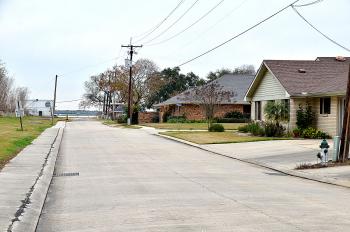
Officials looking to plug gap in Morgan City levee system
A gap in the Morgan City flood protection system at Lakeside Subdivision must be plugged soon in order to protect the city from a cascade of draconian flood insurance rate hikes.
Lee Dragna, chairman of the St. Mary Parish Consolidated Gravity Drainage District 2, said getting a levee 8½ feet above sea level is more of an insurance protection issue than a flood protection issue. While the level of the lake can vary, it is generally about sea level.
The Lakeside levee will be built as a component of Morgan City’s protection, officials have said, but where and how remains unanswered.
“Without a decision on Lakeside, everything will stop,” Dragna said of ongoing levee projects around the city. “We have to seal up the system to keep everybody safe.”
Locating funding has led to uncertainty in how the levee at Lakeside will be constructed. Several options have been discussed with two given the most consideration.
Mayor Frank “Boo” Grizzaffi said the most economical option, putting an approximately 4-foot wall in the front yard of the 15 houses sitting on the lake, is not the first choice.
“Our goal is to protect everybody in the city, including everybody on Lake Palourde Drive,” Grizzaffi said.
Dragna said the two drawbacks to the front yard levee are that it is unattractive to the 15 homeowners and leaves them exposed to the higher flood insurance rates.
Tim Matte, executive director of St. Mary Parish Levee District, said more expensive options exist that will put those homeowners inside of certified levees. Putting a price tag on the options is difficult since there are many variables, he said.
The option most considered is putting about an 8-foot sea break at an undetermined distance into the lake supplemented by a levee in the backyard of the residents living on the lake that is 8½ feet above sea level, Matte said.
The front yard option will cost about $11 million to $13 million; the back yard option will cost about $25.5 million, he said.
Whatever option is chosen is likely to have drawbacks to at least some of the residents living on the lake.
“We want protection but not at the expense of destroying the value of our homes,” Geri Bourgeois, who has lived on the lake since 1974, said. “We want everybody to have reasonable insurance rates. But, we don’t want our property values to drop.”
St. Mary Levee District Commission President Bill Hidalgo said the levee district’s goal is to protect everyone in the parish, including those on Lake Palourde Drive.
Judy Pinho has lived in Lakeside with her husband, L.B., since 1973 said, “We have been paying taxes to the drainage district and we should be included in the protection.”
Any options considered will negatively impact their property values, L.B. Pinho said. Since the property has never flooded and they do not purchase flood insurance, he is concerned about a levee that will give him so little benefit at such personal cost.
“They may as well come here ... and buy the whole thing,” he said.
Bourgeois said homeowners are concerned about long-term costs and effects.
“For years this has been prime property,” Bourgeois said. “We will listen and weigh all the issues.”
A decision will have to be made soon, Dragna said.
“There are 6,680 houses and businesses in this town that we cannot put at risk,” Dragna said.
Grizzaffi said level alignment will be decided after considering the needs of everyone in the city, including on Lake Palourde Road.
“We want to give them an opportunity to be a part of the process,” Grizzaffi said. “But, we won’t be able to make everybody happy.”
While the mayor along with the City Council signs off on the alignment, the drainage district is the entity in charge, Grizzaffi said.
The drainage district has entered a cooperative endeavor agreement with the parish levee district to help locate funding and as a technical advisor.
“The contract to raise the levee … will be ready by spring or fall. As mayor, I am the sponsor of the levee system, but we are working on this as a team,” Grizzaffi said.
Congress mandated that the National Flood Insurance Program become self-sustaining with risk-based premiums that are not federally subsidized. Previously constructed homes not built to the newest flood plain elevations will have steep rate increases either immediately or, in most cases, when they are sold.
To avoid prohibitive flood insurance rates, residences and businesses must be protected from the flood event associated with a storm that has a 1 percent probability of occurring, Dragna said. The event is based on date and computer models studied by the Federal Emergency Management Administration.
- Log in to post comments
